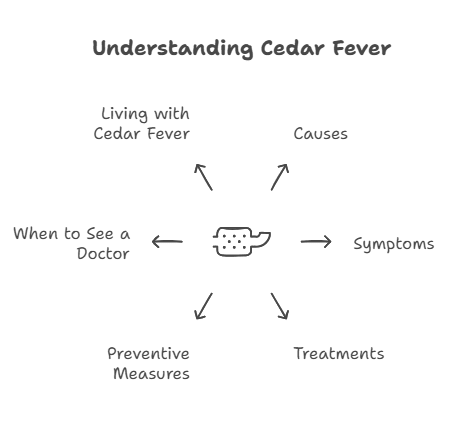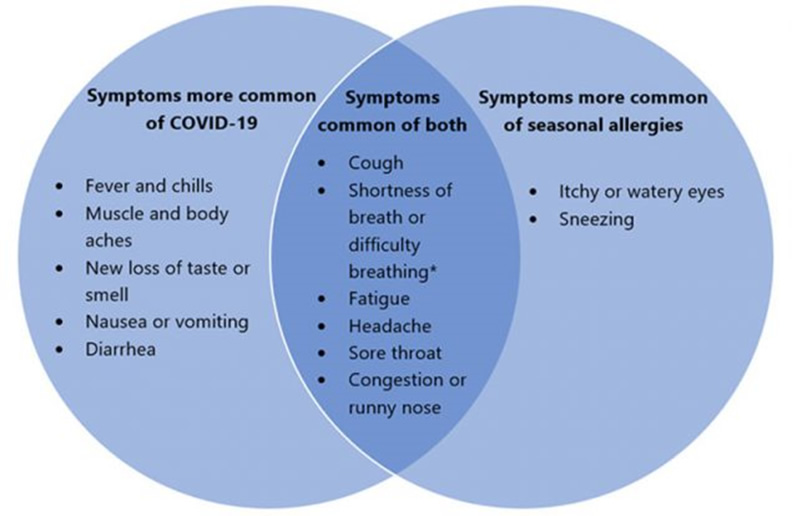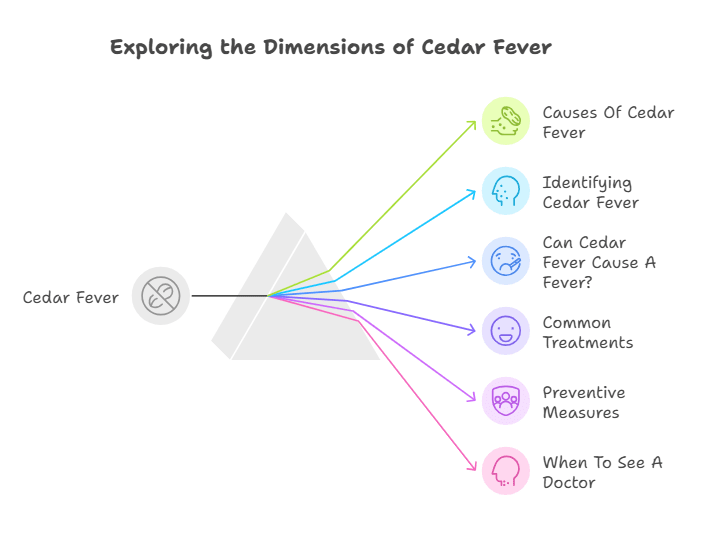Yes, cedar fever can cause a fever. Cedar fever, a seasonal allergy, can trigger various symptoms.
Among these, fever is common due to the body’s response to allergens. Cedar fever happens when pollen from mountain cedar trees fills the air. This pollen can irritate the immune system. People often experience symptoms like sneezing, itchy eyes, and nasal congestion.
Sometimes, the immune reaction can lead to a slight fever. The body’s defense mechanism kicks in, trying to fight off the perceived threat. While it is not an infection, the immune response can cause fever-like symptoms. Understanding cedar fever helps manage these uncomfortable signs. Read on to learn more about the causes, symptoms, and ways to ease cedar fever.
What Is Cedar Fever?
Cedar fever is a common allergy. It happens during cedar pollen season. This season is often in winter. Many people confuse cedar fever with a cold or flu. Cedar fever does not cause a real fever. It gets its name from the cedar trees. These trees release pollen. This pollen makes people feel sick.
Common symptoms include sneezing and itchy eyes. Runny nose and sore throat are also common. Some people may have headaches. You might feel tired. Symptoms can be worse when you are outside. Pollen can make symptoms worse.
Many think cedar fever causes a real fever. This is not true. Cedar fever does not raise body temperature. It is not the same as a flu or cold. Some believe only cedar trees cause this. Other trees can also cause allergies. It is important to know the difference.

Causes Of Cedar Fever
Cedar fever is caused by pollen allergies. The pollen from cedar trees can trigger strong allergic reactions. People may sneeze a lot. They may also have itchy eyes. These symptoms can be very annoying. It is important to stay away from areas with high pollen. Taking allergy medicine can help. Keeping windows closed can also reduce symptoms.
Geographical factors play a big role in cedar fever. Places with many cedar trees have more pollen. Texas is one such place. The wind can spread pollen far and wide. This makes allergies worse. Dry and windy weather increases pollen spread. Living in these areas can be tough for allergy sufferers. Knowing your area’s pollen count helps in planning your day.
Identifying Cedar Fever
Cedar fever does not actually cause a fever. People with cedar fever experience symptoms like a runny nose, itchy eyes, and sneezing. These symptoms are similar to those of common allergies. But, there are some key indicators to look for. Cedar fever can cause a feeling of fatigue and a mild headache. These can sometimes be mistaken for the flu. But, there is no high fever.
Cedar fever is often confused with other allergies. One way to tell the difference is by the time of year. Cedar fever happens mostly in winter. Other allergies, like those from pollen, are more common in spring or summer. Another clue is the location. Cedar fever is common in areas with lots of cedar trees. People who live in these areas may notice more symptoms during cedar pollen season.

Credit: www.texasmedclinic.com
Can Cedar Fever Cause A Fever?
Many people wonder if cedar fever can cause an actual fever. Scientific evidence shows that cedar fever does not usually cause a fever. It is a seasonal allergy. The body reacts to cedar pollen. Common symptoms include sneezing, itchy eyes, and a runny nose. Sometimes, the body may feel warm, but it is not a true fever.
Doctors agree that cedar fever is a type of allergy. It does not cause a real fever. Allergies can make you feel tired and weak. Some people may think they have a fever. Experts suggest taking allergy medicine. This helps reduce symptoms. Always consult a doctor if unsure.
Common Treatments
Many people use over-the-counter medications to relieve symptoms. Antihistamines help with sneezing and itching. Decongestants reduce nasal congestion. Nasal sprays can also help with a stuffy nose. These medications are easy to find. They are available at most pharmacies.
Home remedies can also provide relief. Steam inhalation helps clear nasal passages. Drinking plenty of fluids is important. This keeps the body hydrated. Saline nasal rinses can also help. They flush out allergens from the nose. Rest is another key remedy. It helps the body recover faster.
/Ashe%20Juniper.jpg)
Credit: tfsweb.tamu.edu
Preventive Measures
Cedar fever is a problem for many people. Pollen is the main cause. Avoid going outside when pollen is high. Check the pollen forecast daily. Wear a mask if you need to go out. This helps keep pollen out of your nose and mouth. Change clothes and shower after being outside. This removes pollen from your body. Keep windows and doors closed. This stops pollen from coming inside. Use air purifiers inside your home. They clean the air and reduce pollen levels.
Air purifiers can help a lot with cedar fever. They remove pollen from the air. Place air purifiers in the rooms you use most. Bedrooms and living rooms are good spots. Choose purifiers with HEPA filters. These filters trap small pollen particles. Clean the filters often. Dirty filters do not work well. Keep purifiers on all day. This keeps your home air clean. Air purifiers are a simple way to breathe easier.

When To See A Doctor
Cedar fever does not typically cause a fever. Consult a doctor if you experience severe symptoms or persistent discomfort.
Severe Symptoms
Severe symptoms need medical attention. These include trouble breathing, chest pain, and high fever. Constant coughing or wheezing is also serious. If symptoms last more than a week, see a doctor. Swelling in the face or throat is an emergency. Seek help immediately.
Chronic Cases
Chronic cases of cedar fever also need a doctor’s care. Long-term symptoms can lead to other health issues. Persistent sneezing, runny nose, and itchy eyes are common. If these don’t improve, visit a healthcare provider. They can offer treatments to ease your symptoms. Regular check-ups can help manage chronic conditions better.

Credit: ihisa.com
Living With Cedar Fever
Cedar fever can be tough. Keeping your home clean helps a lot. Use air purifiers to reduce pollen inside. Wash your clothes after being outside. Shower before bed to remove pollen. Drink plenty of water. Stay hydrated. Avoid outdoor activities when pollen counts are high. Wear a mask when outside. Take allergy medications as prescribed. Use eye drops for itchy eyes. Rest well and eat healthy foods. Boost your immune system. Keep windows closed during high pollen days. Vacuum often to remove allergens.
Support groups can be very helpful. Talking to others who understand is comforting. Share tips and experiences with them. Find groups online or in your community. Join forums and social media groups. Ask your doctor for recommendations. Having support makes managing cedar fever easier. Learn new ways to cope from others. Feel less alone with your symptoms. Support groups provide emotional relief. Make new friends with similar struggles. Find encouragement and hope.
Frequently Asked Questions
What Is Cedar Fever?
Cedar fever is an allergic reaction to cedar tree pollen. It occurs mostly in winter. Symptoms include sneezing, itchy eyes, and congestion.
Can Cedar Fever Cause A Fever?
No, cedar fever does not cause an actual fever. Despite its name, it primarily causes allergy symptoms like sneezing and congestion.
How Long Does Cedar Fever Last?
Cedar fever typically lasts from December to February. It coincides with the cedar pollen season. Symptoms can vary in intensity.
What Are The Symptoms Of Cedar Fever?
Symptoms include sneezing, runny nose, itchy eyes, and congestion. Some people may also experience fatigue and headaches.
Conclusion
Cedar fever can cause symptoms similar to the flu. These include runny nose, sneezing, and itchy eyes. But cedar fever itself does not cause an actual fever. It is important to distinguish between allergies and a viral infection. Consult a doctor if symptoms worsen or persist.
Understanding cedar fever helps manage its effects better. Stay informed and take preventive steps. Your health matters.

